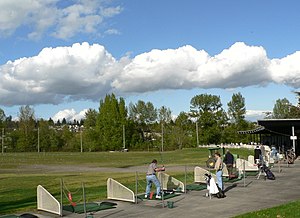Every game of golf is based on playing a number of holes in a given order. A round typically consists of 18 holes that are played in the order determined by the course layout. On a nine-hole course, a standard round consists of two successive nine-hole rounds. A hole of golf consists of hitting a ball from a tee on the teeing ground (a marked area designated for the first shot of a hole), and, once the ball comes to rest, striking it again, and repeating this process until the ball at last comes to rest in the cup. Once the ball is on the green (an area of finely cut grass) the ball is usually putted (hit along the ground) into the hole. The aim of holing the ball in as few strokes as possible may be impeded by various hazards, such as bunkers and water hazards.
Players walk (or in some countries, often drive in motorized electric carts) over the course, either singly or in groups of two, three, or four, sometimes accompanied by caddies who carry and manage the players' equipment and give them advice. Each player plays a ball from the tee to the hole, except that in the mode of play called foursomes, two teams of two players compete, and the members of each team alternate shots using only one ball, until the ball is holed out. When all individual players or teams have brought a ball into play, the player or team whose ball is the farthest from the hole is next to play. In some team events, a player whose ball is farther from the hole may ask his partner to play first. When all players of a group have completed the hole, the player or team with the best score on that hole has the honor, that is, the right to play first on the next tee.
Each player acts as marker for one other player in the group, that is, he or she records the score on a score card. In stroke play (see below), the score consists of the number of strokes played plus any penalty strokes incurred. Penalty strokes are not actually strokes but penalty points that are added to the score for violations of rules or for making use of relief procedures in certain situations.
Scoring
In every form of play, the goal is to play as few shots per round as possible. Scores for each hole can be described as follows:
| Term on a scoreboard | Specific term | Definition |
|---|---|---|
| -4 | triple-eagle (condor) | four strokes under par |
| -3 | double-eagle (albatross) | three strokes under par |
| -2 | eagle | two strokes under par |
| -1 | birdie | one stroke under par |
| 0 | par or even | strokes equal to par |
| +1 | bogey | one stroke more than par |
| +2 | double bogey | two strokes over par |
| +3 | triple bogey | three strokes over par |
The two basic forms of playing golf are match play and stroke play.
- In match play, two players (or two teams) play every hole as a separate contest against each other. The party with the lower score wins that hole, or if the scores of both players or teams are equal the hole is "halved" (drawn). The game is won by the party that wins more holes than the other. In the case that one team or player has taken a lead that cannot be overcome in the number of holes remaining to be played, the match is deemed to be won by the party in the lead, and the remainder of the holes are not played. For example, if one party already has a lead of six holes, and only five holes remain to be played on the course, the match is over. At any given point, if the lead is equal to the number of holes remaining, the match is said to be "dormie", and is continued until the leader increases the lead by one hole, thereby winning the match, or until the match ends in a tie. When the game is tied after the predetermined number of holes have been played, it may be continued until one side takes a one-hole lead, and thereupon immediately wins by one hole.
- In stroke play, every player (or team) counts the number of shots taken for the whole round or tournament to produce the total score, and the player with the lowest score wins. A variant of stroke play is Stableford scoring, where a number of points (two for the target score) are given for each hole, and the fewer shots taken, the more points obtained, so the aim is to have as many points as possible. Another variant of stroke play, the Modified Stableford method, awards points on each hole in relation to par and then adds the points over a round; for more details on this method, see the article on The International, a tournament that uses Modified Stableford scoring.
There are many variations of these basic principles, some of which are explicitly described in the "Rules of Golf" and are therefore regarded "official". "Official" forms of play are, among others, foursome and four-ball games.


